Genre: Action Developer: Bitmap Bros. Publisher: Mindscape Players: 1 Released: 1992
As is no doubt familiar to some, the Genesis wasn’t just home to ports of arcade games and SEGA originals. No, there was another part to its library, games that made the jump from various kinds of computers. Flight simulators were somewhat popular, with a fair number of them coming over to SEGA’s 16-bit machine, along with the occasional RPG and such, but it wasn’t just the IBM machines that added a few titles. It was also the Amiga that ended up having games jump over to the console. Some were well-known titles, like Shadow of the Beast and Star Control, but a few lesser-known ones sneaked in. Among them was a port of the 1991 game Gods by The Bitmap Brothers, whose Amiga version had received quite a few high scores at the time. But was this port’s arrival to the Genesis party in 1992 something to be praised, or should the door have been slammed in its face before it could come in? Read on.
You are a warrior who is unmatched in the world. Your skills with the weapons of war know no equal, and you’ve yet to meet anyone who could match you in a fight. But your target this day isn’t men on the field of battle. Instead, it’s the gods themselves. You wish nothing less than to become one of them. But how? The answer is a simple one: to face the challenge that the gods have laid out for any man to try and overcome. A challenge that requires venturing into an ancient city, besting the four fearsome monsters that hold it captive, and returning the citadel those beasts stole from the gods. And so, it this task that you confront willingly, in hopes of winning one favor of the gods and becoming a god yourself. But as you step into the ancient city, the gods hope for something else to befall you: failure.
The first thing you’ll notice about the game is the graphics, which are quite nice. With plenty of shading and detail on the characters, some pretty smooth animation and solid color choices, the sprites look good as they move about the screen. They have some good variety as well, from your muscle-bound hero, to flying monkey-like enemies and robot-like contraptions, to the different types of ground-based grunts. The bosses also benefit from the same animation, detail and variety levels, with hulking warriors, dragons and such waiting to attack you. There are the occasional oddities with how some animation frames are a bit strange (like your character’s jumping pose), but this quirkiness doesn’t take anything drastic away from the visual quality of the sprites.
The backgrounds in Gods are on a similar page to the characters. With nice amounts of detail and shading, they look good as you go from area to area. And while there are two layers of parallax scrolling that give the visuals a bit of depth, there’s also little in the way of anything animated going on in them. All of the backgrounds themselves are mostly static, save for little animations like switches, opening doors, etc., so it’s good that there’s nice attention to detail in the backgrounds to offset that. The level graphics also don’t really change very much throughout the game in terms of variety. Most of them are basically castle-like stages with bricks, ladders, windows, columns… the typical stuff you’d expect with such backgrounds. Yes, those bricks and such change colors and design, but it’s not until the fourth world where you come to a cave-like area that a more sizable bit of a difference is offered up. So while Gods isn’t as diverse as other games when it comes to stage types, the graphics as a whole are still rather good throughout.
With the music, the game’s got a touch of the “mixed bag” syndrome. The music sounds very much like something from Soldiers of Fortune or Outlander. I say this not just because of the instruments used, but also because of the musical style. It has hints of dance or house in it, with some of the songs in Gods even sounding pretty similar to ones from those other games I mentioned. And while the genre(s) used do clash a bit at times with the ancient civilization setting, the song compositions themselves are well done. Catchy beats are featured throughout, and the tunes have a good length to them before they repeat. Their instrumentation isn’t always the best though, with some synths sounding good and others that can get a bit grating after a while. But overall, despite the small clash of time periods between the sound and graphics, the game has a solid soundtrack.
The sound effects are in the same boat as the music. The grunts of your character as he jumps or gets hit, the tinkling of jewels and keys hitting the floor, the sound of doors and trap doors opening… these effects and a few others are good. From there, it becomes more akin to bits of static or tones for things like the death screams of some creatures, you’re throwing your weapons, and so forth. So again, a little good and a little average, but nothing that offends, thankfully. So, in the end, Gods has an aural quality that just about matches its visual one.
The gameplay in Gods is what you would expect for a game like this… mostly. At first glance, this seems like a pretty straightforward action/platform game. You can jump and duck, throw a steady stream of projectiles (except when crouching), enemies come at you on the ground and in the air, jewels can be gathered up for points, and you collect keys and such to open treasure chests and doors. You’ll deal with stage hazards like drops that can hurt you if you fall too far, spikes and wall-mounted spitting faces, and there are four worlds (with three levels apiece) to get through, with each one having its own boss; however, you’re not helpless by any means.
The game features weapons that can be collected and powered up during the stages, ranging from thrown weapons like daggers and spears, to axes that bounce along the ground and homing spike balls. There are health items to heal you, and special items that can give you a brief protective shield or bring a shopkeeper to you. This shop is where you’ll be able to purchase all manner of weapons, potions and even extra lives with the money you collect during each level. And just to help you a bit more, passwords are provided at the end of each world, so you don’t have to beat it in one sitting, plus little messages along the bottom of the screen to give you clues and such regarding what you pick up and what you need to do. Even so, the game lets you know early on that it’s going to ask a bit more from you than just running, jumping and throwing.
You can only carry three items at a time, which means you’ll be dropping items so you can carry other ones as you work your way through each level. Switches will need to be flipped to open doors/trap doors/make platforms appear, and those same switches can be thrown more than once at times to produce hidden items like jewels or enemies. Some switches even need to be thrown in a more specific order to gain goodies or avoid sudden traps. There are areas where relatively simple puzzles are presented for you to solve for extra loot and gaining keys, while hidden areas will crop up from time to time in a level if you hit the right switch or kill the right enemy. You’ll even need the help of an enemy or two in spots. All of this adds up to a game that mixes lots of foe battling with a more methodical touch in order to proceed.
And now we ask the question, “what’s wrong with the game?” Well, there are a number of shortcomings, with some more annoying than others. The first big issue comes with how enemies spawn. There are times when they pop up right on top of you, or directly behind you. Other enemies come flying quickly from the edge of the screen, giving you very little time to react. This last bit goes in tandem with another gripe to be made – the fact that you’re not in the middle of the screen when it scrolls. You’re usually about one third of the screen’s length from the edge (less if you’re going up a ladder), meaning you’re closer to the edge where some enemies will come streaking in from at times. This just isn’t good game design, as it puts the player at a distinct and unfair disadvantage. Another main area to be picked at are the seemingly mandatory hits. Enemies that are pacing on a floor below you that leave you little room to drop down and attack, shots fired that you can’t jump over because a ledge is right above you, enemies that are suddenly on top of you… these are bits that occur often enough to be annoying.
And finally, there are the controls which seem to have different issues at different times. On the title and name entry screens, they feel mushy with delayed response time, but during the actual game, they’re basically OK and yet still feel mushy. Why? It’s thanks to the amount of time it takes for your character to animate things like turning around, jumping, throwing, etc. Those animations start right when you hit a button, but they delay the actual action by just enough to making things feel laggy, which causes issues when things get hectic onscreen. The game also doesn’t like it when you’re pressing buttons and trying to move, resulting in one canceling out the other with annoying regularity. Then we have the rather unorthodox way you manage your items. You kneel down and hit A to pick an item up, and then hit A again while still kneeling until the green square in your item bar is on an empty space. If you don’t, you’ll either replace that item with the next one you pick up, or you’ll flat out drop the item you just grabbed. Add in how if you hold to the left or right too long, your character will drop off of ladders, and the game’s controls just feel off. Not necessarily broken, just… off.
Other, though more minor, complaints begin in the form of the level progression. At times, you’ll find yourself needing to use a key on a door you were already at a while back, or perhaps hit switches later in the level to open an earlier door. Thankfully, the enemies don’t constantly respawn in cleared areas, and the levels themselves aren’t massive in size. But this mechanic still comes off as padding the game’s length, rather than being creative level design. One more thing to mention are the times when you just sit there waiting for all a set of enemies to respawn… one… at… a time. It gets a touch dull waiting for enemy #1, then #2, and finally #3 or even #4 to appear in the same spot so you can get whatever that final enemy drops. It’s not the gravest gaming sin in the world, but to do this repeatedly in each level does get old after a while.
Finally, a quick note on the differences between the Amiga original and the Genesis port. Obviously, the music isn’t as good sample-wise on the Genesis, but the Genesis version does feature music and sound effects during gameplay, whereas the Amiga version only has (albeit very good) sound effects. There are differences in the backgrounds, such as a colorful gradient-filled backdrop that was changed on the Genesis to be another layer of buildings with a flat-colored sky. The Genesis version is considerably faster. Whether this is simply because of the 50Hz/60Hz thing, or if the Genesis version was sped up intentionally, I’m not sure. But the speed difference is pretty striking. The Genesis has a different opening cinema, and a longer ending cinema. And lastly, while Amiga version has more colors onscreen, it doesn’t look drastically better thanks to the coders doing a pretty good job transferring the visuals to the Genesis’ color palette.
So, what can be said about this somewhat obscure Genesis port? Well, I suppose we could say that while it’s not going to set the world ablaze with awesomeness, but it’s not a horrific game either. The visuals are nice, the music and SFX are pretty good, the hit detection’s decent, and the game does offer a fair bit of challenge. Unfortunately, some of that challenge comes from cheap enemy placement, virtually unavoidable spots of damage (unless you creep through each level), and wonky feeling controls. Factor in some backtracking and how the game forces you to memorize where each enemy is so you can kill it the second it appears, and the game loses some of its steam. You can see that it really had the potential to be a rather good game, but it never quite got there on SEGA’s 16-bit machine. So, while Gods is a decent entry into the genre, it has problems. But if you give it a chance and adapt to its oddities, you might still have some fun exploring and battling your way through.
SCORE: 6 out of 10

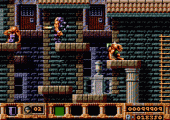
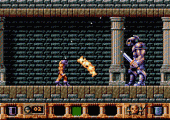
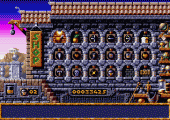
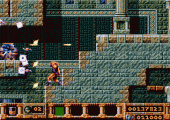
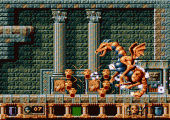
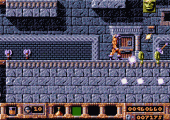
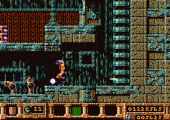
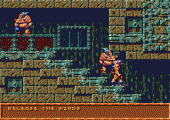
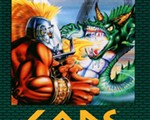
Recent Comments